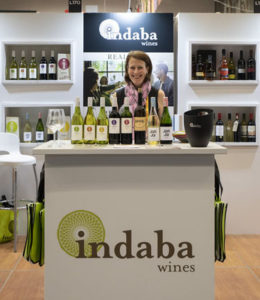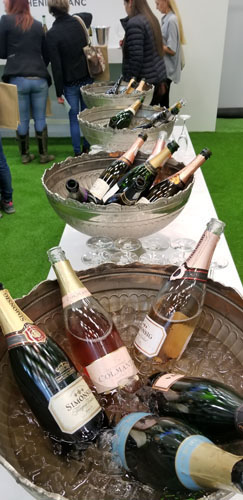story and photos by Kelly Magyarics, DWS
The theme this year for the Southern Hemisphere’s largest wine trade exhibition? Hannuwa, a term dating back 70,000 years to the /Xam San, who painted the rock art in the Cape Fold Mountains and saw the importance of caring for the environment and nurturing the family.

CapeWine, the wine show held every three years hosted by WOSA (Wines of South Africa), is committed to embracing this concept, which translates to “the gathering of good fortune through living in sustainable harmony with our natural environment.” Held at the Cape Town International Convention Centre from September 12–14, 2018, the exhibition brought together producers, importers, media and other industry professionals for three days of tastings and educational opportunities.
It kicked off with a keynote speech on the state of South Africa wine hosted by Siobhan Thompson, CEO of WOSA. The industry, which employs three hundred thousand people, has seen success including its wines being increasingly lauded for their improving quality; but it’s also faced challenges including the extreme drought the region has suffered the past several years. Carina Gous of WOSA, Rick Tigner from Jackson Family Wines, Raymond Milne of Spier and John Lucas of DHL Express wove the importance of taking care of the land into their remarks.
Amorim sponsored a Speaker’s Corner each day, offering short seminars on a variety of topics. One introduced the newly coined W.O. Cape Town, an exciting new region that combines Constantia, Durbanville, Hout Bay and Philadelphia and holds the tagline “Sincere. Vibrant. Sophisticated.” Visitors to the Mother City can get to any of its wineries within twenty minutes, including Benguela Cove Lagoon Estate, Laarman Wines and Storm Wines. Meerendal CWM and marketing manager mused that its wines come from “vines grown with their eyes on Table Mountain.”

Another seminar called The Colour of Wine looked at transformation—the movement towards black-owned and -operated wineries since the abolition of apartheid. Led by Ntsiki Biyela (South Africa’s first black woman winemaker, who now makes wine at Aslina), the class discussed how the landscape of the traditional winemaker is becoming more diverse and inclusive. Biyela submitted that while no real statistics currently exist about the number of black-owned brands in the country, ownership—rather than black winemaking—is what defines veritable change.
Also committed to that mission is BLACC, the Black Cellar Club, whose sommeliers were on hand in the daily free-pour tasting area to answer questions about trends in the country’s main offerings, from chenin black to cinsault to Cape Blends. Pearl Oliver, the club’s national chair, spoke of BLACC’s tireless mission to train wine stewards, encourage women to enter the wine field, create community initiatives to combat alcohol abuse and educate residents to support the local industry. As Oliver put it, “a wine with no story is just fermented grape juice.”

In that free-pour area were some exciting bottles showcasing the stylistic trends producers are taking. Pinot noir is especially promising, with restrained, delicate, juicy examples touting tart cherry and raspberry, moderate extraction and tannins and signature earthiness coming from producers like Hamilton Russell Vineyards in Hemel en Aarde, Bouchard Finlayson in Walker Bay and Paul Cluver and Radford Dale in the Elgin Valley. Equally noteworthy is sauvignon blanc, which show a classic balance of fruit and acidity rather than an overly aggressive style; Cape Point Vineyards in the Cape Peninsula, Ghost Corner from Cape Agulhas and De Grendel Wines in Western Cape are all fresh, herbaceous and mineral-driven bottles. And chenin blanc, the country’s chameleon white grape, is branching off these days into two main styles: the first is fresh, zesty and easy-drinking, while the second is more lush, full-bodied and age-worthy.
The Cape South Coast, the coolest wine region in both climate and buzz-worthiness, comprises the Elgin Valley, Bot River, Hermanus, Elim and Napier. The former has traditionally been known as an apple-growing region, but Master of Wine Richard Kershaw of Kershaw Wines pointed out that “good farmers make good grapes.” Today Elgin has eleven wineries and seventeen producers, and the coolest climate in South Africa–even cooler than Burgundy —due in part to coastal breezes, cloud cover and large diurnal temperature swings, which makes for ideal conditions for pinot noir, chardonnay and sauvignon blanc.
Of course, the most unique opportunity at CapeWine is the chance to chat with winemakers, learn about their viticuland practices and taste through their portfolio. In keeping with the country’s focus on sustainability, Backsberg Estate Cellars is South Africa’s first carbon-neutral winery—but that’s not enough. North America sales and marketing manager Bryce Gillespie said the goal is to be carbon negative. The winery produces a variety of expressions including a Pinotage-based rosé, a Shiraz, and their first vintage of a Méthode Cap Classique, a traditional method sparkling wine crafted from Pinot Noir and Chardonnay.

Charles Brain and Walker Brown, American exchange students–turned-entrepreneurs and the duo behind Lubanzi Wines, were on hand to talk about their story. Named for a stray dog that followed them during a backpacking trip they took in the Wild Coast, the winery produces a Chenin Blanc and a Rhône blend. The duo also supports the Pebble Project, a non-profit organization that assists with medical, dental, and after-school care for children of those in the South African wine industry. It’s a mission that both sums up these vibrant times for the country’s wines and the humanity and community found in the Zulu notion of ubuntu mentioned during that opening keynote speech: “I am because we are.”
Kelly Magyarics, DWS, is a wine, spirits and lifestyle writer, and wine educator, in the Washington, D.C. area. She can be reached through her website, www.kellymagyarics.com , and on Twitter and Instagram @kmagyarics.
